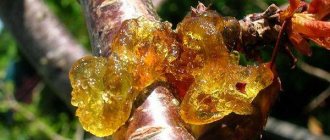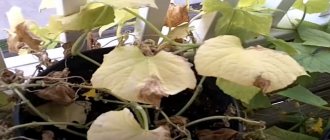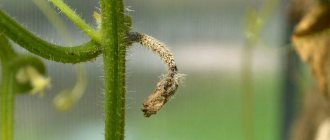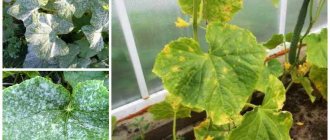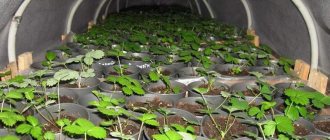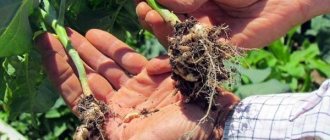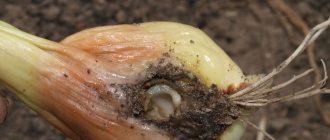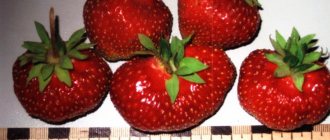There are no strawberry varieties that are completely resistant to all diseases, and the same applies to new hybrids. Each disease develops in certain climatic conditions, soil types and systematic non-compliance with agricultural practices. It is possible to completely cure bushes without loss of yield only in the initial stages of disease development. They manifest themselves in different ways; after a thorough diagnosis, you will be able to select the necessary means of protection.
What is the difference between strawberries and strawberries?
Garden strawberries
The berries of garden strawberries are large, juicy and sour. Strawberries are smaller in size than garden strawberries, slightly pointed, dark burgundy to purple in color, and have a strong flavor.
Strawberries are divided into male and female bushes . How to distinguish them?
- The male strawberry bush produces many shoots and tendrils, blooms profusely, but does not bear fruit - it only pollinates female flowers.
- Female strawberry bushes are similar to male ones, and they can only be distinguished when they bloom: female ones have pistils, male ones have stamens.
- A good strawberry harvest can be harvested if you leave 80% of the female bushes and 20% of the male ones.
Wild strawberries are a completely different matter they have both male and female flowers on one bush, and a good harvest is always guaranteed. Therefore, now many varieties of strawberries, called garden strawberries, have been bred from it. And in fact, what we now call strawberries is called garden strawberries , and strawberries are now grown occasionally.
The diseases of strawberries and garden strawberries are the same.
Possible problems when growing strawberries
Strawberry diseases and pest damage manifest themselves in a variety of ways. The same symptom may indicate completely different problems. The first warning sign is a change in the appearance of the plants. Sometimes this is due to certain errors in care, and the situation normalizes when they are corrected. But there may be other reasons. Most common symptoms:
- Shrinking drying berries. Most often this is due to extreme heat and prolonged lack of precipitation. Strawberries are a moisture-loving crop; proper watering is very important.
- Lack of fruit. This may indicate that the variety belongs to the “weed” category; fruit ovaries on such bushes are absent in principle (they do not bloom at all or form only barren flowers). Other possible reasons are old or, conversely, new plants, fertilizer deficiency, freezing of bushes (especially non-winter-hardy varieties). If the ovaries appear, but dry out and fall off, the most likely cause is the appearance of a weevil.
- Low yield, small berries. Most likely, this is due to problems with pollination, especially if the strawberries are grown in a greenhouse. Bees and bumblebees are not very active in cool, damp weather.
- Yellowing leaves. There are many reasons for this. The most common are planting plants in direct sunlight (they burn the leaves), an overly acidic substrate, moisture deficiency, lack of nutrients - magnesium (the leaves become covered with small yellowish spots), nitrogen (they become lemon-yellow), iron (they turn yellow between the veins) . This may also be due to the appearance of insects that feed on plant juices - aphids, spider mites, weevils.
- Reddening leaves. Towards the end of summer and autumn this is natural. During the growing season, such an unnatural shade can be caused by a potassium deficiency or excessive density of plantings.
- Drying leaves. Most often, the cause is various fungal diseases (any spots, late blight) or the appearance of pests (whitefly, strawberry leaf beetle). In extreme heat, the leaves dry out due to lack of moisture.
- Curling young leaves. This symptom is typical if the plantings are attacked by the strawberry mite.
- Deformed fruits. The main reason is boron deficiency. This may also be due to the fact that the plants were hit by return spring frosts during flowering - because of them, the receptacle suffers.
Photo gallery: symptoms characteristic of common diseases and pests typical of strawberries
Most often, the pulp of strawberries dries out in extreme heat.
The so-called weedy varieties of strawberries bloom, but do not bear fruit, forming barren flowers
Shrinking of strawberries is most often associated with insufficiently active pollination
Yellowness of strawberry leaves is a symptom characteristic of many problems.
Redness of strawberry leaves during the growing season is often caused by potassium deficiency
Strawberry leaves often dry out when various fungal diseases reach the final stage of development.
Curling leaves are a symptom indicating the appearance on strawberries of one of the most dangerous pests for them - the strawberry mite.
The unnatural shape of strawberries for the variety is most often caused by a lack of boron in the soil
Fusarium wilt of strawberry bushes and garden strawberries: description of the disease, how to treat?
Fusarium bush wilt
Fusarium bush wilt is a serious disease that affects the entire bush along with the roots of garden strawberries or strawberries with a parasitic fungus. The disease especially affects bushes in hot weather. The disease is transmitted through the ground if the vegetables that previously grew here suffered from this disease. Can be stored in the ground for several years.
Suitable for treating fusarium:
- "Benorat"
- "Fundazol"
The drug must be diluted according to the attached instructions.
Category: “Questions and answers”
Question No. 1 . Which strawberry varieties are resistant to white spot?
- Olvia,
- Pegasus
- Bagryan,
- Elkat
- Zenith,
- Chapel,
- Selva,
- Tenira,
- Yasna,
- Polka,
- Moling Pandora,
- redgauntlet,
- Pocahontas,
- Kent,
- Ruby pendant,
- redgauntlet,
- Ostara,
- Rusanovka,
- Gum,
- Elsanta.
Question number 2 . What plants are best planted next to or before strawberries?
Good neighbors for garden strawberries are:
- Beans,
- Onion,
- Garlic,
- Dill,
- Parsley,
- Beet.
Question number 3 . Is strawberry white spot dangerous for humans?
The causative agent Ramularia tulasnei is not transmitted to people as a disease. It affects the taste of strawberries, the berries become small and not sweet.
Brown leaf spot of strawberries and garden strawberries: description of the disease, how to treat?
Strawberry leaves affected by brown spot
Brown spot initially affects mainly the older, lower leaves of strawberries and garden strawberries. The disease is expressed in large red-brown spots on the leaves, then they turn black and dry out, but fungal spores remain on them, affecting healthy leaves.
Preventive measures:
- To prevent the proliferation of fungal spores in early spring and autumn, we burn diseased and dry leaves.
- We feed strawberry bushes with phosphorus-potassium fertilizer to increase vitality, and exclude nitrogen.
After harvesting, we treat leaf disease with the following means:
- "Alirin B", 2 tablets per 1 liter of water
- "Fitosporin M", 5 g per 10 l of water
You need to spray the drug solution 3-5 times per season, every 5-7 days.
How it manifests itself
Ramularia tulasnei is a disease caused by the fungus Mycosphaerella fragariae. Appears mainly in spring, on young leaves, in the form of dark purple small dots, 2-4 mm in diameter. On older leaves these will already be rounded spots with a dark red rim. The inside is brown at first, then a white center forms. As they develop, the spots merge and cover the entire leaf. The center of the spot may fall through and the sheet will resemble a sieve.
The peak of the disease occurs in June. During the season, the fungi are transferred to healthy organs, affecting peduncles and runners. Brown oblong spots soon acquire a white center.
Warm, humid weather favors the development of infection. On heavy soils with excess organic matter, the disease is more severe and intense. It takes an average of 20 days from the moment of infection to the formation of new spores.
The optimal temperature for white spotting is +20… +22℃. Massive development of the fungus is observed at the beginning and end of the plant’s growing season. Summer heat and low relative humidity in the middle of the growing season stop the progression of the disease.
Strawberry varieties Festivalnaya, Zenga-Zengana, Dukat, Zarya Real, Rappepa, Talisman are especially susceptible to white spot.
Verticillium wilt of strawberry bushes and garden strawberries: description of the disease, how to treat?
Verticillium wilt of a garden strawberry bush
Verticillium wilt of a garden strawberry bush begins with the old lower leaves becoming covered with dark spots. The spots then cover the entire plant and the roots turn into dry rot and the plant dies. A new bush cannot be planted in this place - the disease remains in the soil and will affect it too.
The disease is treated with the following remedy:
- "Maksim"
Prepare a solution of the drug (2 ml per 1 liter of water) and water the plant at the root 2-3 times per season.
Black rot of strawberries and garden strawberries: description of the disease, how to treat?
Black rot of garden strawberries
The disease black rot is expressed in the fact that ripening strawberry fruits become covered with dark spots. This is also a fungal disease. The disease especially affects fruits if the weather outside is warm and watering is abundant.
If the berries begin to ripen and become infected with black rot, they are hung so that they do not come into contact with the ground.
In the fall, after harvesting, the plants should be sprayed with the following preparation:
- "Ordan"
And next year, in the spring, the plants need to be sprayed with one of the following preparations:
- "Switch"
- "Euparen"
The drug is diluted with water according to the instructions.
External signs of the disease, diagnostic methods
When the fungal pathogen matures, small specks turn into white spots with a brown-black border.
The disease is officially called ramulariasis. The distribution area of the pathogen exactly coincides with all regions where garden strawberries (strawberries) are grown. The appearance of the disease varies from its onset in the spring to the maturation and spread of the fungal pathogen in late summer. During this time, small brown specks turn into white spots, bordered by a brown-black rim.
Often, in places where pathogens are affected, through holes are formed. The plant loses a significant part of the leaf, which negatively affects photosynthesis, and as a result, the harvest. When the disease spreads to 50% of the planting, the number of fruits decreases by 10–15%, with a sharp deterioration in taste.
Gray rot of strawberries and garden strawberries: description, disease prevention, treatment
Gray rot of garden strawberries
If the weather is warm (20-30̊C) and there is a lot of rain, our strawberry and garden strawberry plantations may become sick with gray rot . It looks like this: ripening berries and leaves are covered with brown spots, and on top of the spots are covered, as if with white fluff, with fungal spores. Then the berry is completely covered with fungal spores, but does not fall off, but hangs on the stalk and spreads the disease.
Green berries on bushes infected with the disease do not ripen and dry out. This disease can affect up to 80% of the entire crop.
Diseased bushes can also infect healthy bushes, especially in windy weather or by insects. In addition, if the strawberry was sick last year, then this year, if not treated, it will also get sick, because the disease has not gone away, it successfully overwintered on the diseased bushes, and in early spring, as soon as the sun warmed up, it woke up and continues to do so. your “dirty” business.
To make strawberry bushes less sick, the berry plantation should be placed in a ventilated place, on a hill.
Attention . If there is a lot of nitrogen in the soil where strawberries are planted, the bushes are dark green, lush, and they are more susceptible to gray rot disease.
To prevent the disease, in the spring, as soon as the strawberry bushes have grown, they are sprayed with one of the following products:
- "Derozal"
- "Euparen"
- "Switch"
- "Topsin M"
- "Alirin B", 2 tablets per 1 liter of water
- "Fitosporin M", 5 g - per 10 liters of water
If the summer turns out to be rainy, the strawberry bushes will have to be treated with the drug again before flowering.
Attention . To prevent diseases of strawberry bushes, do not plant them in the place where potatoes used to grow.
What factors influence the development of diseases in strawberries
The causative agents of all diseases persist in the soil and on plant debris.
Strawberries can be grown in one place for no longer than 3 years in a row, then the beds need to be moved to another part of the garden; the worst predecessor for berries is potatoes. Spores and bacteria accumulated in the soil will provoke outbreaks of diseases that are epidemic in nature, then it will no longer be possible to cure the crop. Attention!
Infections spread with water, in the wind, they are carried by harmful insects, spores or bacteria can persist on shoes and garden tools.
The plant should be planted in open, well-lit and ventilated beds, while avoiding drafts. Strawberries cannot be planted in places where water accumulates and stagnates. In a constantly humid environment, fungal diseases actively develop, and they are considered the most dangerous. During rainy periods, it is necessary to organize drainage in the beds and, if possible, loosen the soil.
Poor-quality seedlings (even if they look strong) can become a source of infection of plantings; seedlings should be purchased only from proven, reliable places. Do not neglect recommendations for planting certain varieties; failure to follow planting plans and thickening are a common cause of disease. Strawberries do not tolerate proximity to weeds; they clog the plantings, create shade and a humid environment.
Late blight of strawberries and garden strawberries: description of the disease, how to treat
Late blight of the garden strawberry bush in the chronic stage
Late blight is distinguished between transient and chronic . infected with chronic late blight looks like this:
- The leaves are small, cup-shaped, grayish in color.
- Diseased bushes are smaller and more frail than healthy ones
- Antennae rarely appear
- Flowers and fruits are formed occasionally
- After a few years the bush dies
Late blight can affect strawberries and garden strawberries, both green and beginning to ripen. The berries affected by the disease look as if they are covered with soft skin that is beginning to rot, tasteless, and have a bitter taste. Then the berries are completely covered with such skin, and are preserved as if embalmed. The causative agents of late blight are drops of dew or rain.
To prevent strawberries from getting late blight when they begin to ripen, even before flowering, for preventive purposes the bushes are treated with one of the following drugs:
- "Ridomil"
- "Glyokladin"
- "Trichotsin"
- "Quadris"
- "Metaxil"
- "Trichodermin"
- "Planriz"
We dilute the preparations with water according to the instructions and spray the plant 2-3 times per season.
Strawberry and garden strawberry leaf rust: description of the disease, how to treat
Rust of leaves of garden strawberries
rust is expressed in the formation of growths on the leaves containing rusty powder in the voids - fungal spores. Diseased leaves die, and then the entire plant dies. If you notice rust on the leaves of strawberries or garden strawberries, the bushes should be treated with one of the following products:
- "Baktofit"
- "Agromedicine"
- "Forecast"
- "Titanium"
- "Bayleton"
- Bordeaux mixture, 1%
- "Propi Plus"
- "Title 390"
- "Alirin B", 2 tablets per 1 liter of water
We dilute one of the preparations according to the instructions and spray the plants 2-3 times per season.
White spot
The appearance of ramularia (or white spot) is caused by the fungi Mycosphaerella fragariae (Tul.) Lind. They breed throughout the warm season. Particularly active in warm rainy weather. White spot can develop throughout the strawberry growing season. The peak of fungal disease occurs at the flowering stage.
White spotting on strawberry leaves
The first signs of ramularia are the appearance of red-brown dots on the leaves. Over time, they enlarge and become white in the middle. Then holes appear in their place and the leaves become perforated. With severe damage, the spots merge and increase in size. The disease spreads to the stems. Some of the leaves die off, the plant becomes depressed, and the quality of the berries deteriorates. The development of fungal diseases is promoted by:
- excess organic fertilizers;
- dense plantings of strawberries;
- irrigation by sprinkling;
- heavy dew;
- wet weather.
The appearance of fungal ramularia can lead to a loss of 15 to 100% of the crop. Infected strawberries are treated with the following fungicides: Topaz, Switch, Radomil, Euparen, Bayleton. In case of severe damage, the bushes are destroyed. Preventive measures to combat white spotting:
- fertilizing strawberries after picking berries with potassium-phosphorus fertilizers;
- avoiding an excess of organic, nitrogen fertilizers;
- compliance with the planting scheme;
- standard treatment of strawberries in the spring against diseases - removal of diseased bushes, mulch, pruning of old leaves, mustaches;
- spraying with Bordeaux mixture (3%), antifungal agents containing copper.
Wrinkling of leaves of strawberries and garden strawberries: description of the disease, how to treat
Wrinkling of leaves of garden strawberries
The leaves of strawberries and garden strawberries wrinkle, their edges turn yellow, the veins on the leaves are bent, the leaves become smaller, and the plant dies - this is how the disease wrinkling manifests itself. The carrier of the disease is aphids. You can save plants and the future harvest if you promptly treat the bushes with drugs against the disease and against aphids.
You need to treat strawberry leaves with the drug “Farmayod”, diluting 3-6 ml in 10 liters of water. Spray 2-3 times per season, every 2 weeks.
Prevention of strawberry diseases
When viruses, fungi or insects have already become active, crop losses cannot be avoided. To prevent losses, preventive measures are needed.
General measures to prevent diseases and pests:
- Timely weeding and destruction of weeds. Clearing up plant debris at the end of the season and pruning leaves in the fall. Weeds and old leaves may contain insects, fungal spores, and bacteria.
- Maintaining crop rotation. Change of site every three years. Prohibition on planting after unfavorable predecessors - potatoes, tomatoes, pumpkins.
- Purchasing planting material from trusted suppliers. Often, unscrupulous sellers give away strawberries that are already contaminated with something.
- Compliance with the norm and frequency of watering, timely application of fertilizing - ash, mullein solution, complex mineral fertilizers.
The most effective protection of strawberry beds from most diseases and pests are preventive measures, including compliance with agricultural practices and timely spraying. If you do not take care of protecting berry plantations, there is a risk of losing the harvest completely.
0
0
Copy link
Powdery mildew on the leaves and berries of strawberries and garden strawberries: description of the disease, how to treat?
Powdery mildew of garden strawberries
If it is a rainy summer, powdery mildew affects the still green berries and leaves of strawberries and garden strawberries. At first it is a barely noticeable white coating, and then rot, as if sprinkled with flour, spreads throughout the berry, and the leaves curl into tubes.
It helps against powdery mildew if you treat the bushes before flowering with the following preparation:
- "Trichodermin", according to instructions
- "Alirin B", 2 tablets per 1 liter of water
- "Baktofit", 3 g - per 1 liter of water
We dilute one of the preparations and spray it 3-5 times per season, every 5-7 days.
Spot development
The development of white and brown spots begins very early, already in April. Infection occurs completely unnoticed by gardeners. The spots on fresh leaves appear small, and they affect only some part of the leaves.
But in May or early June, spot infestation is already noticeable on strawberry bushes. At this time, massive infection of strawberry leaves occurs. And the most unpleasant thing is that it occurs at a time when the berries are ripening, and it is no longer possible to spray the bushes with chemicals.
Folk remedies for combating diseases of strawberries and garden strawberries: recipes, how to treat
If the disease is not advanced, folk remedies will also help.
To combat diseases of strawberries and garden strawberries, you can also use folk remedies; they are not harmful to us, unlike chemicals.
Homemade mustard will help fight gray mold
Recipe 1. Mustard infusion
For the infusion you need:
- 100 g mustard powder
- 10 liters of boiling water
Preparing the infusion:
- Pour mustard powder with boiling water and leave for 2 days.
- Add another 10 liters of water to the infusion, mix, and spray on the diseased strawberry bushes with a spray bottle.
Note : For preventive purposes, we plant beds with garlic or onions next to the strawberry plantation.
To combat powdery mildew, regular hay will help.
Recipe 2. Infusion of rotted hay
For the infusion you need:
- 1 kg hay
- 3 liters of water
Preparing the infusion:
- We take rotted hay, fill it with water and leave for 5 hours.
- We filter, throw away the hay, and spray the strawberry bushes with the infusion in the evening.
- We repeat the procedure after 5-7 days. During the season you need to spray 3-5 times.
Note : In the spring, for preventive purposes against all fungal diseases, it would be good to sprinkle strawberry bushes with ash. You only need a little of it, it is recommended to take 70 g per 1 m2.
Recipe 3. Whey diluted with water (1:10) helps against powdery mildew If the diluted whey does not help much, you need to add a few drops of iodine and spray the strawberries once every 3 days.
Recipe 4 . If last year the strawberries suffered from powdery mildew , starting next spring, spray them with a weak solution of soda ash .
To combat fungal diseases of leaves in the spring (fusarium, ramularia, late blight, rust, brown spot, venticillium), an infusion of garlic will help.
Recipe 5. Garlic infusion
For the infusion you need:
- 500 g garlic
- 10 liters of water
Preparing the infusion:
- Chop the garlic, add water and leave for 3 days.
- Strain the infusion through cheesecloth, dilute it with 10 liters of water and spray the strawberry bushes.
To combat fungal and viral diseases of leaves and fruits in the spring, an iodine solution will help.
Recipe 6. Iodine solution
For the solution you need:
- 10 ml iodine
- 10 liters of water
Preparing the infusion:
- Dissolve a bottle of iodine in 10 liters of water, mix and spray the strawberry bushes once every 10 days, starting in May.
against gray rot and powdery mildew .
Recipe 7. Potassium permanganate solution
For the solution you need:
- 2 tsp. potassium permanganate
- 10 liters of water
Preparing the infusion:
- Dissolve potassium permanganate in water, mix thoroughly and spray the diseased strawberry bushes.
So, now we know how to treat strawberries and garden strawberries if they get sick.
